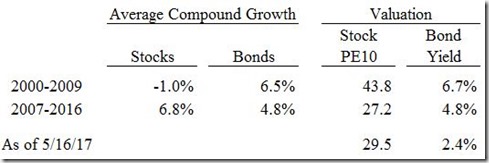I Hate Predicting Investment Returns
I generally spend little time talking about investments, investment returns and the outlook for the markets. Instead, my focus tends to be more on planning, be it investment, financial, estate, risk management, etc. The reason for this is simple: I have no idea what the investment markets are going to do, especially in the shorter-term, and I cannot control this. Making planning recommendations and decisions is something over which we have much more control. Therefore, that’s where more energy is spent.
Of course, investments and returns have to be part of the planning process, with reasonable expectations built into planning projections. For the last three years (beginning in Summer 2014), I have been writing to clients and discussing the reality of expected returns given current market conditions. Basically, the message has been to expect lower than historical average returns in the next 5-10 years. This lower return has largely played out, with the exception being in large cap US stocks. Also note that we have had little volatility in that time (i.e. no sustained pullback in the markets, either stocks or bonds). To see this, click here and look at the annualized returns for the last 3 years across several asset classes.
With that recent history and my general dislike of discussing future investment returns explained, here are my thoughts on this unavoidable topic. Stocks have limited upside and the ever-present risk of quite a bit of downside. Bonds have even less return potential. Not exactly a rosy outlook, but one that must be understood in order to set reasonable expectations going forward. While there are endless measures of valuation and ways to “predict” return, I believe the following table captures the message.
This is a simple table, but there’s a lot here. This shows 10-year returns of US large cap stocks and 10-year US Treasury bonds over two different periods. The first 10-year period is the so-called lost decade in stocks, which contains both the dot.com bust and the Great Recession. The annual return on stocks was slightly negative (including dividends, yikes!) while the annual return on bonds was 6.5%. Now, look to the valuation section and see where stocks and bonds began this period. Stocks were near an all-time high price-earnings multiple of 43.8 (the long term average is closer to 17). Bonds began the period with a yield of 6.7%. Stocks performed poorly after a massive run up in prices in the late 1990s while bonds returned in-line with the beginning yield.
Now look at the second period. Stocks began at an elevated PE multiple, but not nearly as high as the first, and went on to have an annual return of 6.8%. Bonds again returned in-line with their (lower) beginning yield. Note: bonds don’t always have a return equal to beginning yield, it just happened to turn out that way in these periods.
Now look at the current measures. Stocks are at a valuation a little above the beginning of 2007. Bonds are yielding 2.4%. To restate, I can’t (and won’t) predict what investment markets will do. But we can make some observations based on the past and basic bond math.
- While stocks are not attractively priced, the current valuation has seen several subsequent 10-year periods with decent returns in the past, such as 2007-2016, but…
- Most of those 10-year periods came with large drops in stocks somewhere along the way.
- Bonds cannot return but so much. If yields remain around current levels, they will return the current yield. If yields move up, returns can be less. This depends on the amount and timing of yield increases. If there is a panic in stocks, bonds would likely benefit.
So, the basic message is that stocks probably have more return potential in the next 10 years, which is generally the case in most 10-year periods, with both stocks and bonds expected to have muted returns. This expectation is being baked into my discussions with clients and the planning projections we do. This is particularly challenging for less risk tolerant clients. There is no one size fits all to this conundrum and each situation must be addressed individually to make informed decisions.
Finally, a few more thoughts about the above table.
- No table like this has all the answers.
- Only large cap US stocks and 10-year US Treasury bonds are represented. Other parts of the global stock and bond markets have different valuation metrics, reminding us of the value of and need for diversification.
- Individual client risk tolerance cannot be ignored to reach for return. Successful investing is essentially the ability to reduce big mistakes. Violating one’s risk tolerance increases the chance of a future big mistake.

